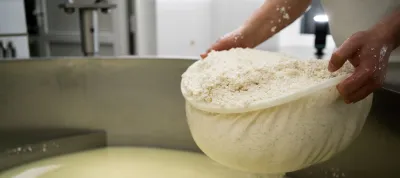General information
RDP Priority
- P3. Food chain and risk management
RDP Focus Area
- 3A: Agri-food chain integration & quality
RDP Measure
- M04: Investments in physical assets
Beneficiary type
- Farmer / land manager
Summary
Disposal of whey, a byproduct of cheese production, presents several disadvantages for dairies that can negatively impact their operational efficiency and economic viability. Underuse of whey also represents a missed opportunity for value-added products. Instead of being discarded, whey can be processed into protein supplements, used in animal feed, or provide a source of biofuel.
The ‘Greek Family Farm’ is a dairy business rearing livestock to produce organic and conventional milk products. The company applies green principles to reduce its environmental footprint, and sought a circular economy solution by reusing whey waste within a bioenergy generator.
CAP funding of EUR 2.5 million was awarded to the farm firm for co-financing a sophisticated wastewater treatment plant based on anaerobic technology. This uses biochemical mechanisms to degrade the whey’s organic load and convert it into valuable biogas (consisting mainly of methane). Energy from the waste is used to power the dairy.
Results
- Reduced consumption of gaseous fuel mixtures (propane-butane) by more than 50%.
- Improved the whey management carbon footprint by at least 30%.

Promoter
The Greek Family Farm
Funding
Total budget 5 000 000 (EUR)
RDP support: 2 500 000 (EUR)
Private/own: 2 500 000 (EUR)
Keywords
Ressources
Liens
Context
The disposal of whey, a byproduct of cheese production, presents several disadvantages for dairies that can negatively impact their operational efficiency and economic viability. One primary concern is the financial burden associated with whey disposal methods. Dairies often incur substantial costs in managing whey waste, whether through transportation to treatment facilities or investing in on-site processing technologies. These expenses can erode profit margins, particularly for smaller operations that may lack the resources to implement efficient waste management systems.
Improper disposal of whey can lead to environmental issues, such as water pollution and nutrient overloads in local ecosystems. When discharged into waterways without adequate treatment, whey contributes to eutrophication, which depletes oxygen levels and harms aquatic life. This not only poses regulatory risks but can also damage a dairy's reputation among consumers increasingly concerned about sustainable practices.
Underuse of whey represents a missed opportunity for value-added products. Instead of being discarded, whey can be processed into protein supplements, used in animal feed, or provide a source of biofuel. Dairies that don’t capitalise on these alternatives may risk finding themselves at a competitive disadvantage in an industry where innovation and sustainability are ever more paramount.
The ‘Greek Family Farm’ is a dairy business rearing livestock to produce milk products. It is specialised in quality organic and conventional dairy products. The company applies green principles to reduce its environmental footprint and it sought a circular economy solution by reusing whey within a bioenergy generator.
Objectives
Project goals centred on:
- developing a complete solution for managing the main dairy byproduct (whey), the disposal of which had been a major problem for dairies.
- minimising electricity consumption during whey waste management.
- producing large amounts of biogas as boiler fuel for energy production, reducing external fuel demand for propane-butane by more than 80% initially, and then by 100% after two years.
- reducing CO2 emissions by more than 50% compared to conventional aerobic whey waste techniques.
Activities
Using whey waste from dairy production as a fuel for bioenergy involves several critical activities that ensure the effective conversion of this byproduct into a sustainable energy source. The initial phase is the collection and characterisation of whey waste, where various parameters such as chemical composition, volume, and potential contaminants are assessed. This step is crucial for determining the feasibility of using whey in bioenergy systems.
Following characterisation, the second activity involves pretreatment processes aimed at enhancing the digestibility of whey. Techniques such as thermal treatment or enzymatic hydrolysis may be employed to break down complex carbohydrates and proteins, thereby increasing the availability of fermentable sugars for subsequent biochemical conversions.
The third activity involves anaerobic digestion or fermentation, wherein microorganisms convert the pretreated whey into biogas or bioethanol. This process not only generates renewable energy but also mitigates environmental concerns associated with whey disposal.
During the final stage, optimisation and integration strategies are developed to maximise energy yield while minimising operational costs, ensuring that the project is both economically viable and environmentally sustainable.
Main results
Core project outcomes were:
- reduced consumption of gaseous fuel mixtures (propane-butane) by more than 50%;
- improved whey management carbon footprint by at least 30%.
Key lessons
Dairies can significantly enhance sustainability by using whey waste as a bioenergy source.
This approach not only reduces environmental impact but also lowers operational costs.
By converting whey into energy, dairies can minimise waste disposal issues, create renewable energy, and contribute to a circular economy, ultimately fostering economic and ecological resilience.
Spyros Nastopoulos

